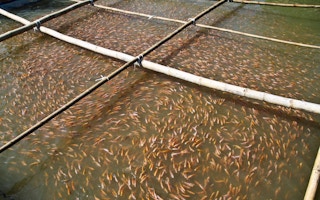Global food security is all about sourcing enough protein, on a genuinely sustainable basis, for a population in excess of nine billion people in the second half of this century. There’s now an increasingly lively debate about the balance between protein from plants, protein from meat and dairy, and protein from marine and novel sources, with all sorts of nutritional, agronomic and environmental perspectives needing to be taken into account. The Protein Challenge 2040, a consortium of organisations convened by Forum for the Future, is tracking innovations and opinion through an open online hub, The Future of Protein.
The fastest-growing source of protein today is still aquaculture, which has seen increases of around 8 per cent per annum since the mid-1970s. With total volumes now at around 75 million tonnes per annum, more fish is being farmed than beef!
While China is still “the undisputed birthplace and modern Leviathan of aquaculture, producing nearly 60 per cent of the world’s farm-raised fish and shellfish”, much of the more recent growth came from South East Asia in response to a huge surge in demand for shrimp in the rich world. As Joel K Bourne Jr documents in his book, The End of Plenty:
“During the 1980s, roughly a quarter of the Earth’s remaining tropical mangroves were bulldozed to build shrimp ponds that now produce a third of the world’s supply, driven largely by demand from the United States, Europe and Japan. Las Vegas alone consumes some 60,000 pounds of shrimp a day – roughly 150,000 shrimp cocktails – most of which is imported from Asia.”
It’s not just the mangroves that have suffered. Coastal pollution of every kind has rocketed; the use of antibiotics and pesticides has grown proportionately; and there’s now growing concern about high levels of banned substances and other contaminants in imports from China, Thailand, Vietnam, Taiwan and Chile. This is an industry that faces one humungous clean-up challenge. As did the Scottish and Norwegian farmed salmon industry back in the 1980s – and the good news is that there’s been an extraordinary turn-around here.
A fascinating paper appeared in the journal ‘World Agriculture’ in July 2014, authored by Dr Shepherd and Professor Little, who refer to massive improvements in salmon farming in particular over the last 30 years, countering concerns over the use of antibiotics and the presence of contaminants in farmed salmon, and the threat of farm effluent to coastal ecosystems. Furthermore, the authors go on to contest that:
“Compared with terrestrial livestock, fish are better suited for farming, being cold-blooded with neutral buoyancy in water, which enhances production efficiency, and farmed fish are more productive than wild fish as they use less energy and lack predators. Recent detailed studies of the salmon farming industry in Norway have shown that it is a more efficient way of producing nutrients for human consumption than either pig or chicken farming, as demonstrated by its climate impact, area of land occupation, and use of non-renewable phosphorus resources. Farmed salmon retain nutrients more efficiently and are better converters of feed nutrients to nutrients for human consumption than the most efficient land animal production.”
All that may come as a bit of a surprise to critics of the industry, but it matters enormously from the point of view of food security: making more protein available for more people is simply not enough – it has to be produced on a genuinely sustainable basis.
What really matters here is the FiFo ratio – Fish-in, Fish-out. Back in the 1980s, the industry used about 4.5kg of fishmeal (and 7.2kg of fish oil) to get 1kg of farmed salmon. By 2010, that had come right down to 1.4kg of fishmeal (and 2.3kg of fish oil) – a transformation achieved almost entirely by substituting plant ingredients (mainly from soybeans) for marine ingredients.
“
There’s still a real question about long-term security (and sustainability) of populations of the small oily fish on which the industry depends.
But there is a bit of a trade-off here. One of the reasons why farmed salmon is so valuable from a nutritional point of view is its relatively high concentration of Omega-3 Long Chain Polyunsaturated Fatty Acids – or LC-PUFAs in the trade! You don’t get those from soybean oil, which means that the replacement of fish oil by plant oil in salmon feeds is reducing levels of Omega-3 – at exactly the time when there is increasingly fierce competition for fish oil from the nutritional supplements industry.
And that’s the crunch point: 70 per cent of fishmeal and 90 per cent of fish oil is still being consumed by the aquaculture industry. And although the industry is doing a better and better job of using all the fish waste from processing factories (for both meal and oil), there’s still a real question about long-term security (and sustainability) of populations of the small oily fish on which the industry depends.
The worst possible outcome would be a massive increase in the volume of krill that is caught to make up for declining populations of small fish elsewhere. Norway, Japan and South Korea are all turning to the huge population of krill in the Antarctic as a new source of feed for the industry, but this could have a devastating effect on the whole marine food chain in that part of the world.
Better by far to look to an increasingly exciting range of micro-algae products – both protein and oils. And this is another of those areas of innovation we’re tracking on The Future of Protein!
Jonathon Porritt is the founder director of Forum for the Future. This post is republished from The Futures Centre with permission.


















